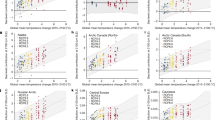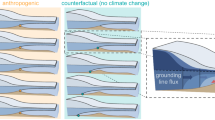Abstract
Climate adaptation and flood risk assessments1,2 have incorporated sea-level rise (SLR) projections developed using semi-empirical methods3,4,5 (SEMs) and expert-informed mass-balance scenarios2,6. These techniques, which do not explicitly model ice dynamics, generate upper bounds on twenty-first century SLR that are up to three times higher than Intergovernmental Panel on Climate Change estimates7. However, the physical basis underlying these projections, and their likelihood of occurrence, remain unclear8,9,10. Here, we develop mass-balance projections for the Antarctic ice sheet within a Bayesian probabilistic framework10, integrating numerical model output11 and updating projections with an observational synthesis12. Without abrupt, sustained, changes in ice discharge (collapse), we project a 95th percentile mass loss equivalent to ∼13 cm SLR by 2100, lower than previous upper-bound projections. Substantially higher mass loss requires regional collapse, invoking dynamics that are likely to be inconsistent with the underlying assumptions of SEMs. In this probabilistic framework, the pronounced sensitivity of upper-bound SLR projections to the poorly known likelihood of collapse is lessened with constraints on the persistence and magnitude of subsequent discharge. More realistic, fully probabilistic, estimates of the ice-sheet contribution to SLR may thus be obtained by assimilating additional observations and numerical models11,13.
This is a preview of subscription content, access via your institution
Access options
Subscribe to this journal
Receive 12 print issues and online access
$209.00 per year
only $17.42 per issue
Buy this article
- Purchase on Springer Link
- Instant access to full article PDF
Prices may be subject to local taxes which are calculated during checkout




Similar content being viewed by others
References
Parris, A. P. et al. Global Sea Level Rise Scenarios for the United States National Climate Assessment (NOAA Climate Program Office, 2012).
Katsman, C. et al. Exploring high-end scenarios for local sea level rise to develop flood protection strategies for a low-lying delta—the Netherlands as an example. Climatic Change 3–4, 617–645 (2011).
Vermeer, M. & Rahmstorf, S. Global sea level linked to global temperature. Proc. Natl Acad. Sci. USA 106, 21527–21532 (2009).
Grinsted, A., Moore, J. & Jevrejeva, S. Reconstructing sea level from paleo and projected temperatures 200 to 2100. Clim. Dynam. 34, 461–472.
Jevrejeva, S., Moore, J. C. & Grinsted, A. How will sea level respond to changes in natural and anthropogenic forcings by 2100? Geophys. Res. Lett. 37, L07703 (2010).
Pfeffer, W. T., Harper, J. T. & O’Neel, S. Kinematic constraints on glacier contributions to twenty first century sea-level rise. Science 321, 1340–1343 (2008).
Meehl, G. A. et al. in Climate Change 2007: The Physical Science Basis (eds Solomon, S. et al.) 748–845 (Cambridge Univ. Press, 2007).
Willis, J. K. & Church, J. A. Regional sea-level projection. Science 336, 550–551 (2012).
Lowe, J. A. & Gregory, J. M. A sea of uncertainty. Nature Rep. Clim. Change 4, 42–43 (2010).
Little, C. M., Urban, N. M. & Oppenheimer, M. Probabilistic framework for assessing the ice sheet contribution to sea level change. Proc. Natl Acad. Sci. USA 110, 3264–3269 (2013).
Joughin, I., Smith, B. E. & Holland, D. M. Sensitivity of twenty first century sea level to ocean-induced thinning of Pine Island Glacier, Antarctica. Geophys. Res. Lett. 37, L20502 (2010).
Shepherd, A. et al. A reconciled estimate of ice sheet mass balance. Science 338, 1183–1189 (2012).
Gladstone, R. M. et al. Calibrated prediction of Pine Island Glacier retreat during the 21st and 22nd centuries with a coupled flowline model. Earth Planet. Sci. Lett. 333–334, 191–199 (2012).
Oppenheimer, M., O’Neill, B. C., Webster, M. & Agrawala, S. Climate change—the limits of consensus. Science 317, 1505–1506 (2007) 0036-8075.
Jevrejeva, S., Moore, J. C. & Grinsted, A. Potential for bias in twenty first century semiempirical sea level projections. J. Geophys. Res. Atmos. 117, D20116 (2012).
Joughin, I. & Alley, R. B. Stability of the West Antarctic Ice Sheet in a warming world. Nature Geosci. 4, 506–513 (2011).
Milne, G. A., Gehrels, W. R., Hughes, C. W. & Tamisiea, M. E. Identifying the causes of sea-level change. Nature Geosci. 2, 471–478.
Gregory, J. M. et al. Twentieth-century global-mean sea-level rise: is the whole greater than the sum of the parts? J. Clim. http://dx.doi.org/10.1175/JCLI-D-12-00319.1 (2012).
Thompson, W. G., Curran, H. A., Wilson, M. A. & White, B. Sea-level oscillations during the last interglacial highstand recorded by Bahamas corals. Nature Geosci. 4, 684–687 (2011).
Van de Berg, W. J., van den Broeke, M., Ettema, J., van Meijgaard, E. & Kaspar, F. Significant contribution of insolation to Eemian melting of the Greenland ice sheet. Nature Geosci. 4, 679–683 (2011).
Rignot, E. et al. Recent Antarctic ice mass loss from radar interferometry and regional climate modelling. Nature Geosci. 1, 106–110 (2008).
Zwally, H. & Giovinetto, M. Overview and assessment of antarctic ice-sheet mass balance estimates: 1992–2009. Surv. Geophys. 32, 1–26 (2011).
Rignot, E. Changes in West Antarctic ice stream dynamics observed with ALOS PALSAR data. Geophys. Res. Lett. 35, L12505 (2008).
Shuman, C. A., Berthier, E. & Scambos, T. A. 2001–2009 elevation and mass losses in the Larsen A and B embayments, Antarctic Peninsula. J. Glaciol. 57, 737–754 (2011).
Jenkins, A. et al. Observations beneath Pine Island Glacier in West Antarctica and implications for its retreat. Nature Geosci. 3, 468–472 (2010).
Thomas, R. et al. Accelerating ice loss from the fastest Greenland and Antarctic glaciers. Geophys. Res. Lett. 38, L10502 (2011).
Bamber, J. L., Riva, R. E. M., Vermeersen, B. L. A. & LeBrocq, A. M. Reassessment of the potential sea-level rise from a collapse of the West Antarctic ice sheet. Science 324, 901–903 (2009).
Bamber, J. L. & Aspinall, W. P. An expert judgement assessment of future sea level rise from the ice sheets. Nature Clim. Change http://dx.doi.org/10.1038/nclimate1778 (2013).
Pritchard, H. D. et al. Antarctic ice-sheet loss driven by basal melting of ice shelves. Nature 484, 502–505 (2012).
Winkelmann, R., Levermann, A., Frieler, K. & Martin, M. A. Uncertainty in future solid ice discharge from Antarctica. Cryosphere Disuss. 6, 673–714 (2012).
Goldberg, D. N. et al. Investigation of land ice-ocean interaction with a fully coupled ice-ocean model: 1: Model description and behaviour. J. Geophys. Res. 117, 2156–2202 (2012).
McKay, N. P., Overpeck, J. T. & Otto-Bliesner, B. L. The role of ocean thermal expansion in Last Interglacial sea level rise. Geophys. Res. Lett. 38, L14605 (2011).
Acknowledgements
C.M.L. is grateful for financial support from the Science, Technology and Environmental Policy programme in the Woodrow Wilson School of Public and International Affairs at Princeton University and the Carbon Mitigation Initiative in the Princeton Environmental Institute. The authors thank K. Keller, O. Sergienko and Y. Liu for many helpful suggestions. We also thank A. Shepherd and the Ice Sheet Mass Balance Exercise team for promptly providing data.
Author information
Authors and Affiliations
Contributions
C.M.L, N.M.U and M.O. designed the research. C.M.L. conducted the data analysis and wrote the manuscript. M.O and N.M.U. contributed extensively to the paper writing, editing and revision.
Corresponding author
Ethics declarations
Competing interests
The authors declare no competing financial interests.
Supplementary information
Supplementary Information
Supplementary Information (PDF 3220 kb)
Rights and permissions
About this article
Cite this article
Little, C., Oppenheimer, M. & Urban, N. Upper bounds on twenty-first-century Antarctic ice loss assessed using a probabilistic framework. Nature Clim Change 3, 654–659 (2013). https://doi.org/10.1038/nclimate1845
Received:
Accepted:
Published:
Issue Date:
DOI: https://doi.org/10.1038/nclimate1845
This article is cited by
-
Fate and future climatic role of polar ice sheets
Nature (2019)
-
Revisiting Antarctic ice loss due to marine ice-cliff instability
Nature (2019)
-
Antarctic ice losses tracking high
Nature Climate Change (2018)
-
Temporal controls on silicic acid utilisation along the West Antarctic Peninsula
Nature Communications (2017)
-
Expert judgement and uncertainty quantification for climate change
Nature Climate Change (2016)



